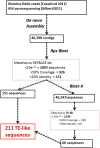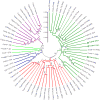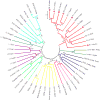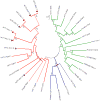Transposable elements in the Anopheles funestus transcriptome
- PMID: 28424974
- PMCID: PMC5584644
- DOI: 10.1007/s10709-017-9964-z
Transposable elements in the Anopheles funestus transcriptome
Abstract
Transposable elements (TEs) are present in most of the eukaryotic genomes and their impact on genome evolution is increasingly recognized. Although there is extensive information on the TEs present in several eukaryotic genomes, less is known about the expression of these elements at the transcriptome level. Here we present a detailed analysis regarding the expression of TEs in Anopheles funestus, the second most important vector of human malaria in Africa. Several transcriptionally active TE families belonging both to Class I and II were identified and characterized. Interestingly, we have identified a full-length putative active element (including the presence of full length TIRs in the genomic sequence) belonging to the hAT superfamily, which presents active members in other insect genomes. This work contributes to a comprehensive understanding of the landscape of transposable elements in A. funestus transcriptome. Our results reveal that TEs are abundant and diverse in the mosquito and that most of the TE families found in the genome are represented in the mosquito transcriptome, a fact that could indicate activity of these elements.The vast diversity of TEs expressed in A. funestus suggests that there is ongoing amplification of several families in this organism.
Keywords: Anopheles funestus; Transcriptome; Transposable elements.
Figures









Similar articles
-
Novel transposable elements from Anopheles gambiae.BMC Genomics. 2011 May 23;12:260. doi: 10.1186/1471-2164-12-260. BMC Genomics. 2011. PMID: 21605407 Free PMC article.
-
Losing identity: structural diversity of transposable elements belonging to different classes in the genome of Anopheles gambiae.BMC Genomics. 2012 Jun 22;13:272. doi: 10.1186/1471-2164-13-272. BMC Genomics. 2012. PMID: 22726298 Free PMC article.
-
P elements and MITE relatives in the whole genome sequence of Anopheles gambiae.BMC Genomics. 2006 Aug 18;7:214. doi: 10.1186/1471-2164-7-214. BMC Genomics. 2006. PMID: 16919158 Free PMC article.
-
Mosquito transposable elements.Insect Biochem Mol Biol. 2004 Jul;34(7):631-44. doi: 10.1016/j.ibmb.2004.03.016. Insect Biochem Mol Biol. 2004. PMID: 15242704 Review.
-
Transposable elements in mosquitoes.Cytogenet Genome Res. 2005;110(1-4):500-9. doi: 10.1159/000084983. Cytogenet Genome Res. 2005. PMID: 16093703 Review.
Cited by
-
Exploring the midgut physiology of the non-haematophagous mosquito Toxorhynchites theobaldi.Open Biol. 2024 Jul;14(7):230437. doi: 10.1098/rsob.230437. Epub 2024 Jul 3. Open Biol. 2024. PMID: 38955221 Free PMC article.
-
Annotation of transposable elements in the transcriptome of the Neotropical brown stink bug Euschistus heros and its chromosomal distribution.Mol Genet Genomics. 2023 Nov;298(6):1377-1388. doi: 10.1007/s00438-023-02063-9. Epub 2023 Aug 30. Mol Genet Genomics. 2023. PMID: 37646857
-
Comparative genomic and transcriptomic analyses of transposable elements in polychaetous annelids highlight LTR retrotransposon diversity and evolution.Mob DNA. 2021 Oct 29;12(1):24. doi: 10.1186/s13100-021-00252-0. Mob DNA. 2021. PMID: 34715903 Free PMC article.
-
A Genomic Survey of Mayetiola destructor Mobilome Provides New Insights into the Evolutionary History of Transposable Elements in the Cecidomyiid Midges.PLoS One. 2021 Oct 11;16(10):e0257996. doi: 10.1371/journal.pone.0257996. eCollection 2021. PLoS One. 2021. PMID: 34634072 Free PMC article.
References
-
- Adams MD, Celniker SE, Holt RA, Evans CA, Gocayne JD, Amanatides PG, Scherer SE, Li PW, Hoskins RA, Galle RF, George RA, Lewis SE, Richards S, Ashburner M, Henderson SN, Sutton GG, Wortman JR, Yandell MD, Zhang Q, Chen LX, Brandon RC, Rogers YH, Blazej RG, Champe M, Pfeiffer BD, Wan KH, Doyle C, Baxter EG, Helt G, Nelson CR, Gabor GL, Abril JF, Agbayani A, An HJ, Andrews-Pfannkoch C, Baldwin D, Ballew RM, Basu A, Baxendale J, Bayraktaroglu L, Beasley EM, Beeson KY, Benos PV, Berman BP, Bhandari D, Bolshakov S, Borkova D, Botchan MR, Bouck J, Brokstein P, Brottier P, Burtis KC, Busam DA, Butler H, Cadieu E, Center A, Chandra I, Cherry JM, Cawley S, Dahlke C, Davenport LB, Davies P, de Pablos B, Delcher A, Deng Z, Mays AD, Dew I, Dietz SM, Dodson K, Doup LE, Downes M, Dugan-Rocha S, Dunkov BC, Dunn P, Durbin KJ, Evangelista CC, Ferraz C, Ferriera S, Fleischmann W, Fosler C, Gabrielian AE, Garg NS, Gelbart WM, Glasser K, Glodek A, Gong F, Gorrell JH, Gu Z, Guan P, Harris M, Harris NL, Harvey D, Heiman TJ, Hernandez JR, Houck J, Hostin D, Houston KA, Howland TJ, Wei MH, Ibegwam C, Jalali M, Kalush F, Karpen GH, Ke Z, Kennison JA, Ketchum KA, Kimmel BE, Kodira CD, Kraft C, Kravitz S, Kulp D, Lai Z, Lasko P, Lei Y, Levitsky AA, Li J, Li Z, Liang Y, Lin X, Liu X, Mattei B, McIntosh TC, McLeod MP, cPherson D, Merkulov G, Milshina NV, Mobarry C, Morris J, Moshrefi A, Mount SM, Moy M, Murphy B, Murphy L, Muzny DM, Nelson DL, Nelson DR, Nelson KA, Nixon K, Nusskern DR, Pacleb JM, Palazzolo M, Pittman GS, Pan S, Pollard J, Puri V, Reese MG, Reinert K, Remington K, Saunders RD, Scheeler F, Shen H, Shue BC, Sidãon-Kiamos I, Simpson M, Skupski MP, Smith T, Spier E, Spradling AC, Stapleton M, Strong R, Sun E, Svirskas R, Tector C, Turner R, Venter E, Wang AH, Wang X, Wang ZY, Wassarman DA, Weinstock GM, Weisenbach J, Williams SM, Woodage T, Worley KC, Wu D, Yang S, Yao QA, Ye J, Yeh RF, Zaveri JS, Zhan M, Zhang G, Zhao Q, Zheng L, Zheng XH, Zhong FN, Zhong W, Zhou X, Zhu S, Zhu X, Smith HO, Gibbs RA, Myers EW, Rubin GM, Venter JC. The genome sequence of Drosophila melanogaster. Science. 2000 Mar 24;287(5461):2185–95. - PubMed
-
- Arensburger P, Megy K, Waterhouse RM, Abrudan J, Amedeo P, Antelo B, Bartholomay L, Bidwell S, Caler E, Camara F, Campbell CL, Campbell KS, Casola C, Castro MT, Chandramouliswaran I, Chapman SB, Christley S, Costas J, Eisenstadt E, Feschotte C, Fraser-Liggett C, Guigo R, Haas B, Hammond M, Hansson BS, Hemingway J, Hill SR, Howarth C, Ignell R, Kennedy RC, Kodira CD, Lobo NF, Mao C, Mayhew G, Michel K, Mori A, Liu N, Naveira H, Nene V, Nguyen N, Pearson MD, Pritham EJ, Puiu D, Qi Y, Ranson H, Ribeiro JM, Roberston HM, Severson DW, Shumway M, Stanke M, Strausberg RL, Sun C, Sutton G, Tu ZJ, Tubio JM, Unger MF, Vanlandingham DL, Vilella AJ, White O, White JR, Wondji CS, Wortman J, Zdobnov EM, Birren B, Christensen BM, Collins FH, Cornel A, Dimopoulos G, Hannick LI, Higgs S, Lanzaro GC, Lawson D, Lee NH, Muskavitch MA, Raikhel AS, Atkinson PW. Sequencing of Culex quinquefasciatus establishes a platform for mosquito comparative genomics. Science. 2010;330(6000):86–8. - PMC - PubMed
MeSH terms
Substances
Grants and funding
LinkOut - more resources
Full Text Sources
Other Literature Sources

